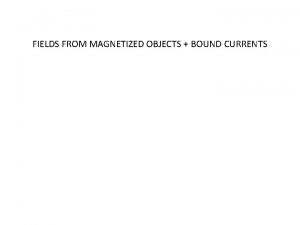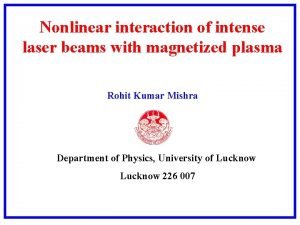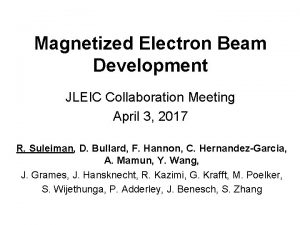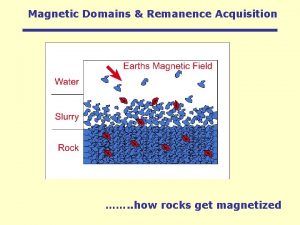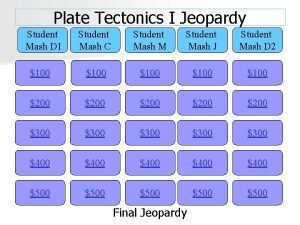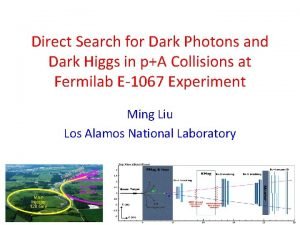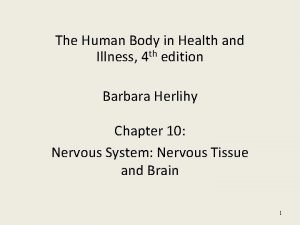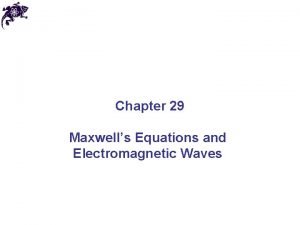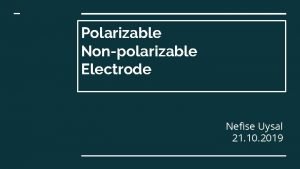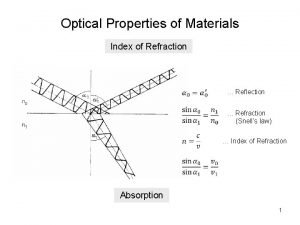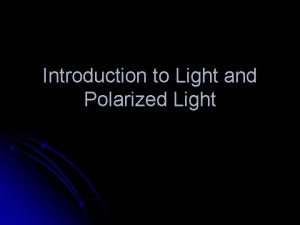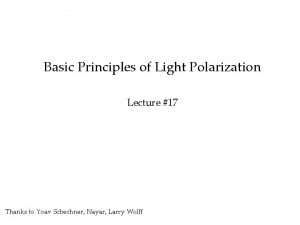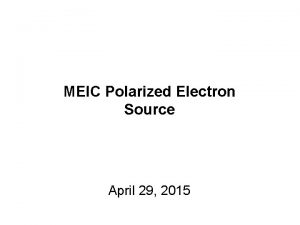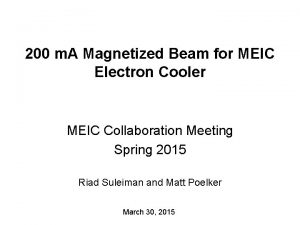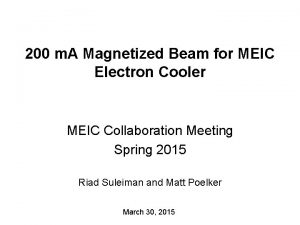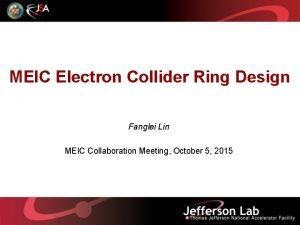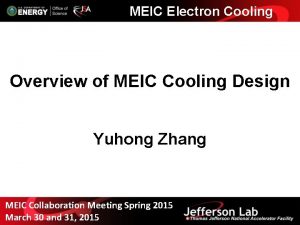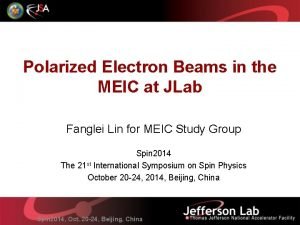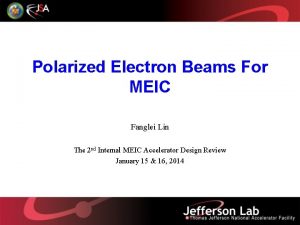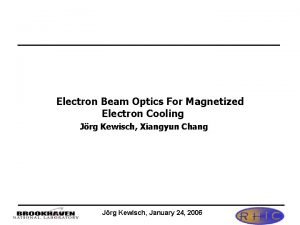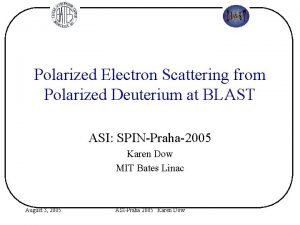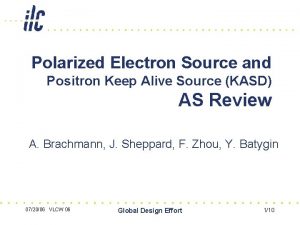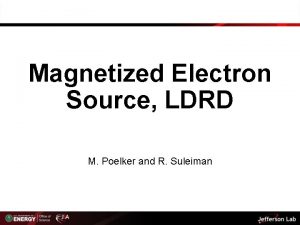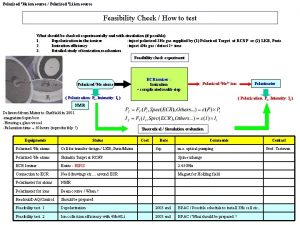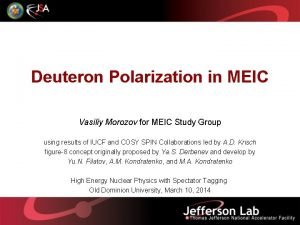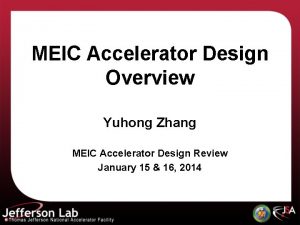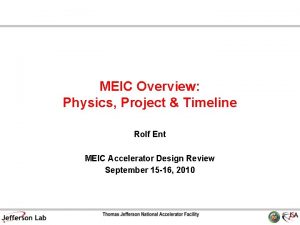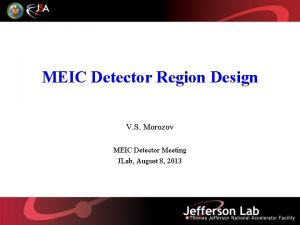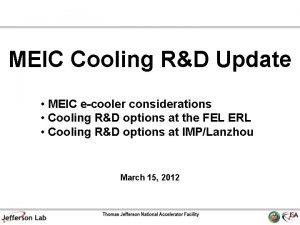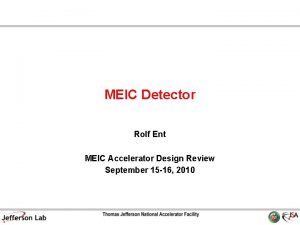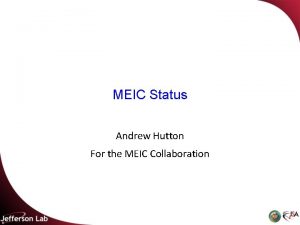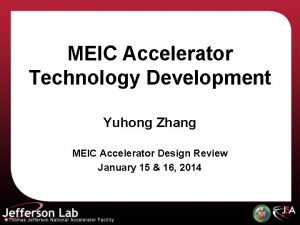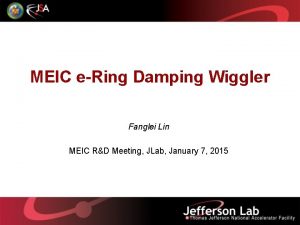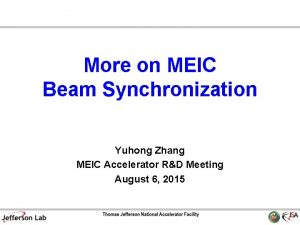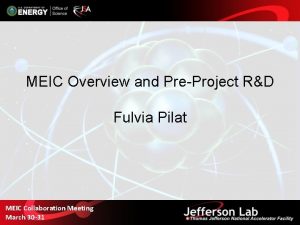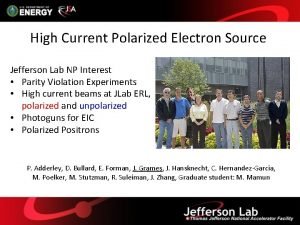MEIC Polarized Electron Source Magnetized source for MEIC


























- Slides: 26

MEIC Polarized Electron Source & Magnetized source for MEIC Electron Cooler MEIC Collaboration Meeting Spring 2015 Riad Suleiman March 31, 2015

MEIC Polarized Electron Source

MEIC Polarized Source Bunch Charge 26 p. C – 6. 6 p. C Helicity Reversal 72. 07 µs … 220 bunches at 68. 05 MHz (14. 69 ns) 700 ms – 12 ms … … … 3. 233 µs Damping Time 3 Ge. V – 12 Ge. V Slide 3

Source Parameter Comparison Parameter CEBAF JLab/FEL EIC e. RHIC EIC MEIC Cornell ERL LHe. C CLIC ILC Polarization Yes No Yes Yes Ga. As / Ga. As. P Bulk Ga. As Width of microbunch (ps) 50 35 100 50 2 100 1000 Time between microbunches (ns) 2 13 106 14. 69 0. 77 25 0. 5002 337 499 75 9. 4 68. 05 1300 40 1999 3 Width of macropulse - - - 3. 233 µs - - 156 ns 1 ms Macropulse repetition rate (Hz) - - - 2 x 83 - - 50 5 0. 4 133 5300 26 77 640 960 4800 Peak current of microbunch (A) 0. 008 3. 8 53 0. 52 38. 5 6. 4 9. 6 4. 8 Laser Spot Size (cm, diameter) 0. 1 0. 5 0. 6 0. 3 0. 5 1 19 188 7. 4 500 32 12 6 0. 2 10 50 0. 001 100 25 0. 015 0. 072 Photocathode Microbunch rep rate (MHz) Charge per microbunch (p. C) Peak current density (A/cm 2) Average current from gun (m. A) K 2 Cs. Sb * Unpolarized: Bulk Ga. As (Cs, F), K 2 Cs. Sb, Na 2 KSb, … Polarized: Ga. As/Ga. As. P (Cs, F). Proposed

Managing Large Bunch Charge I. Larger Laser Size (reduces space-charge emittance growth and suppresses surface charge limit) II. Higher Gun Voltage: Ø Reduce space-charge emittance growth, maintain small transverse beam profile and short bunch-length; clean beam transport Ø Compact, less-complicated injector III. To accelerate large bunch charge in CEBAF: use RF feedforward system for C 100 cryomodules Slide 5

JLab 500 k. V Inverted Gun 7” 5” 200 k. V Inverted Gun § Longer insulator § Spherical electrode Slide 6

Magnetized Source for MEIC Electron Cooler Ø Ø Ø MEIC Electron Beam Cooling Requirements Thermionic Gun Photogun Magnetized (Angular-momentum-dominated) Beam Summary Slide 7

Bunched Magnetized Electron Beam for Cooling Bunch Length 100 ps (3 cm) Repetition Rate 748. 5 MHz Bunch Charge 267 p. C Peak Current 2. 67 A Average Current 200 m. A Emitting Area 6 mm ɸ Transverse Normalized Emittance 10 s microns Solenoid Field at Cathode 2 k. G Slide 8

Source Performance & Dependencies Ø Thermal Emittance: Intrinsic property of a cathode. Depends on work function, surface roughness, laser wavelength, temperature. Ø Achievable Current: QE, laser wavelength, laser power, laser damage, heating, temperature. Ø Bunch Charge: laser peak power, repetition rate, active cathode area. Ø Cathode Lifetime: ion back bombardment, dark current, contamination by residual gas, evaporation, beam loss, halo beam. Slide 9

Thermionic Gun Example 1: TRIUMF e-Linac for photo-fission of actinide target materials to produce exotic isotopes: § § § Ba. O: 6 mm diameter, 775˚C Grid at 650 MHz Gun HV: 300 k. V Average beam current: 25 m. A Bunch charge: 38 p. C Normalized emittance: 30 microns. Emittance is dominated by the electric field distortion caused by the grid. Production target sets no requirement on beam emittance Slide 10

Example 2: MAX-LAB Thermionic – Photocathode RF Gun. Thorin et al. , NIM A 606, 291 (2009): § Thermionic: for storage ring injection § § § Ba. O: 6 mm diameter, 1100˚C Bunch charge: 0. 2 n. C, 3 GHz Bunch length: 1 ps after energy filter Peak current: 200 A. Average beam current: 600 m. A Normalized emittance: 35 microns To switch, reduce T=1100˚C to T=700˚C § Photocathode: for FEL § § § Bunch charge: 0. 2 n. C Laser: 9 ps, 10 Hz, 263 nm Average beam current: 2 n. A Normalized emittance: 5. 5 microns QE: 1. 1 x 10 -4 Slide 11

Example 3: Thermionic Gun and 1. 5 Me. V Injector of BINP’s Novo. FEL. B. A. Knyazev et al. , Meas. Sci. Tech. 21, 054017 (2010): Gun HV Maximum peak current Maximum average current Maximum bunch repetition rate Bunch length Bunch charge Normalized emittance 300 k. V 1. 8 A 30 – 45 m. A 22. 5 MHz 1. 3 ns 1. 5 – 2 n. C 10 microns Slide 12

Photogun Example 1: JLab 200 k. V Inverted dc Gun with K 2 Cs. Sb photocathode: § § Average beam current: 10 m. A Laser: 532 nm, dc Lifetime: very long (weeks) Thermal emittance: 0. 7 microns/mm(rms) Mammei et al. , Phys. Rev. ST AB 16, 033401 (2013) Slide 13

Example 2: JLab 350/500 k. V Inverted Gun: 200 k. V Gun 350/500 k. V Gun Chamber 14” ɸ 18’’ ɸ Cathode 2. 5” T-shaped 6” ɸ Ball Cathode Gap 6. 3 cm Inverted Ceramic 4” long 7” long HV Cable R 28 R 30 HV Supply Spellman 225 k. V, 30 m. A Glassman 600 k. V, 5 m. A Maximum Gradient 4 MV/M 7 (10) MV/m Achieved 350 k. V with no FE (December 2013), next: o Keep pushing to reach 500 k. V o Run beam with K 2 Cs. Sb photocathode Slide 14

Example 3: Cornell dc Gun with K 2 Cs. Sb photocathode: § § § Gun HV: currently operating at 350 k. V (designed 500 -600 k. V) Average beam current: 100 m. A Bunch charge: 77 p. C Bunch length: 10 ps, 1. 3 GHz Normalized emittance: <0. 5 microns Slide 15

Magnetized Beam and Emittance Compensation Solenoid (B ~2 k. G) z (magnetized beam) I. Magnetized Cathode: Ø To produce magnetized electron beam to ensure zero angular momentum inside cooling-solenoid section) II. Magnetized Injector: Ø To compensate space-charge emittance growth Solenoids (Bz~2 k. G) (space-charge emittance growth compensation) Slide 16

Summary I. Thermionic gun would be our first choice (less maintenance but may need complicated injector): Ø TRIUMF/BINP Gun with Inverted Ceramic II. To allow for laser pulse shaping, a photogun could be an option: Ø JLab 350/500 k. V Inverted Gun and JLab K 2 Cs. Sb III. If one gun cannot provide 200 m. A, then use two or three guns and combine beams using RF combiner or dipole magnet Slide 17

LDRD: 200 m. A Magnetized Beam I. Use JLab 350/500 k. V Inverted Gun and JLab K 2 Cs. Sb II. Design and build Cathode Solenoid III. Generate magnetized beam IV. Measure beam magnetization: V. i. Measure beam emittance vs. beam size ii. Measure directly using slit and screen Study transportation of magnetized beam (must preserve magnetization) VI. Measure magnetized photocathode lifetime at high currents Slide 18

Magnetized Electron Cooling Slide 19

Busch’s Theorem • On entering or exiting solenoid, beam acquires a kick that makes beam to rotate • Busch’s Theorem: Canonical angular momentums is conserved, • Canonical angular momentum: • Magnetic emittance: emag[microns] ~ 30 B[k. G] σe[mm]2 Slide 20

Magnetized Cooling Solenoid Cathode Ion Beam B=0 Electron Beam BCath_Sol = 2 k. G Electrons born in uniform Bz σe= Rlaser = 3 mm Upon exit of Cathode Solenoid BCool_Sol = 2 T Upon entering Cooling Solenoid σe= 1 mm 21

Why: Magnetized beam? I. Magnetic field limits transverse motion of electrons; cooling is determined by longitudinal velocity spread II. Cooling time for non-magnetized beam: Slide 22

Cooling Solenoid I. Cooling solenoid: 30 m long and 2 T field II. Electron and ion are moving at same speed in cooling section (solenoid) III. Inside cooling solenoid, electron beam is calm: not to have any angular motion IV. Cooling solenoid must have high parallelism of magnetic field lines: Slide 23

Cooling Rate: Dependencies on Electron Beam Properties I. III. IV. V. VI. Proportional to average beam current (does not depend on peak current) Independent of ion beam intensity Proportional to cooler length Magnetized cooling is less dependent on electron beam transverse emittance Cooling rates with magnetized electron beam are ultimately determined by electron longitudinal energy spread only, which can be made much smaller than transverse one. Non-magnetized beam depends on transverse electron velocity (a weak field may be used for focusing –i. e. , FNAL dc cooler, 100 G) Slide 24

Electron – ion Recombination Suppression I. Suppresses ion-electron recombination in cooling section (for non-magnetized cooling, a small magnetic field maybe required to suppress recombination) Slide 25

Paraxial Beam Envelope Equation Acceleration Damping Injector Solenoids (for space-charge emittance growth compensation) Space Charge Cathode Solenoid Cooling Solenoid Cathode Emission Bz~2 k. G Bz~20 k. G Slide 26
 Bound surface current
Bound surface current Magnetized
Magnetized Magnetized
Magnetized Magnetized
Magnetized The cross section below depicts magnetized oceanic crust
The cross section below depicts magnetized oceanic crust Polarized pluralist model
Polarized pluralist model Dark sector upgrades
Dark sector upgrades Homunculus
Homunculus A polarizer blocks 75% of a polarized light beam.
A polarizer blocks 75% of a polarized light beam. Polarizable electrode
Polarizable electrode Index of refraction formula
Index of refraction formula Definition of light
Definition of light Polarized wave
Polarized wave Humanitr
Humanitr Datorkunskap för nybörjare
Datorkunskap för nybörjare Ekologiskt fotavtryck
Ekologiskt fotavtryck Rita perspektiv
Rita perspektiv Ministerstyre för och nackdelar
Ministerstyre för och nackdelar Redogör för vad psykologi är
Redogör för vad psykologi är Claes martinsson
Claes martinsson Ramsa geometriska former
Ramsa geometriska former Offentlig förvaltning
Offentlig förvaltning Klassens frågetecken rim
Klassens frågetecken rim Nyckelkompetenser för livslångt lärande
Nyckelkompetenser för livslångt lärande Mästar lärling modellen
Mästar lärling modellen Klädsel i rom
Klädsel i rom Vilotidsbok
Vilotidsbok
